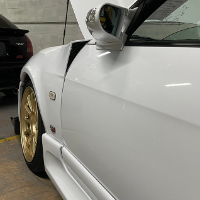Leak Down Test Results
Announcements
-
Similar Content
-
Latest Posts
-
A realistic expectattion of how long it has to last also comes down to.... when do you think you will be banned from registering and driving old petrol powered shitters? It's 27 years since that thing was built. It probably rusted out 15 years ago. It was probably repaired and looked OK for another 10. If you do a similarish bodge job now, or perhaps slightly better with some actual rust conversion and glassing, then.... get another 10-15 years out of it, after which you'll only be permitted by the CCP to drive electric cars manufactured in their Shenzen zone anyway.
-
Let me assume that the concern over a manual ECU is that the NeoDET that you have was an auto and has an auto ECU. That ECU will not be a problem, but you WILL have to Nistune it. And you would have to Nistune it even if you had a manual ECU, because the turbo ECUs will shit the bed if they do not have all the things that they were told they have to have, to be happy. The big one being the TCS CU, which you won't have in your car. Anyway, with an auto ECU (which I have running my originally auto NeoDET in an R32) Nistune allows you to put in a Stagea image which doesn't panic about the absent TCS, and allows you to override a whle bunch of other annoyances that would otherwise see the check engine light on 100% of the time. Also, you can't wind up the power very far on the stock NeoDET ECUs without Nistune, because the boost sensor gets in the way. Nistune allows you to push that problem much further up the dial. Do you even have the boost sensor with the engine? Without it, you are SOL and will need an aftermarket ECU (or to find a sensor somewhere, god knows where). I can't tell you what the wiring loom differences are in a 34. But what Duncan said above needs to be considered. When you say "loom", does that include the transmission loom? Because you will need to swap out the auto tranny loom for the equivalent manual loom, and get rid of the neutral/park start interlock (basically hot wire it).
-
I have had the r3c in for years now, maybe close to 7 years and it has never missed a beat, anyone can drive it. Super easy to drive around town, the hotter it gets does get a little hard but it holds the power easy as
-
Shit thing to find eh? I guess the big issue is that whatever "fix" you do now, it might slow the rust down but won't fix it. I just wanted to add that in no way is fixing sheet metal in 3 dimensions the place to start with welding....that is a pro only job because its too hard to work out where things should be, let alone doing a clean enough job that it can look OK and still be strong too. I needed to get a new rear quarter panel on the GTR and it took a pro weeks to get the old one off cleanly, new one on in the right place and looking somewhat like it should have with most of the previous connecting panels in place. Gluing a couple of bits of metal together with a welder in the garage is doable, but that is totally different to doing panel replacement
-
This seems to be a very popular swap since all the turbo skyline prices went through the roof! I'll let someone more familiar chime in, but I understand that yes you probably want to swap the loom in to swap out the auto TCM stuff. You should not assume everything just plugs in either, you need to check at least the ECU wiring diagram for any differences at the plug at the left headlight and probably the ones near the ECU that join the dash loom too
-




Recommended Posts
Create an account or sign in to comment
You need to be a member in order to leave a comment
Create an account
Sign up for a new account in our community. It's easy!
Register a new accountSign in
Already have an account? Sign in here.
Sign In Now